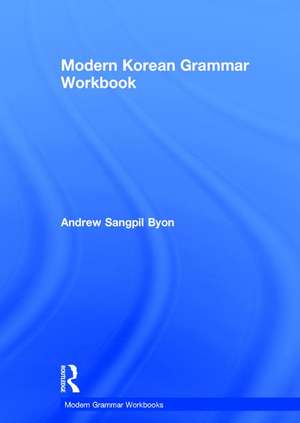Modern Korean Grammar Workbook: Modern Grammar Workbooks
Autor Andrew Byonen Limba Engleză Hardback – 13 iun 2017
The aim of the Modern Korean Grammar Workbook is to strengthen the reader’s understanding of the main volume, Modern Korean Grammar.. Designed for those who have already acquired the basics of the language, this workbook provides abundant innovative exercises for both essential grammatical features and everyday usage and functions (e.g., giving advices, greetings, requesting, etc.).
The Modern Korean Grammar Workbook is an ideal practice tool for Korean-as a foreign/second (KFL) learners. No prior knowledge of grammatical terminology is assumed and it can be used both independently and alongside Modern Korean Grammar.
| Toate formatele și edițiile | Preț | Express |
|---|---|---|
| Paperback (1) | 363.68 lei 43-57 zile | |
| Taylor & Francis – 19 iun 2017 | 363.68 lei 43-57 zile | |
| Hardback (1) | 1010.53 lei 43-57 zile | |
| Taylor & Francis – 13 iun 2017 | 1010.53 lei 43-57 zile |
Preț: 1010.53 lei
Preț vechi: 1232.35 lei
-18% Nou
Puncte Express: 1516
Preț estimativ în valută:
193.40€ • 201.37$ • 163.44£
193.40€ • 201.37$ • 163.44£
Carte tipărită la comandă
Livrare economică 10-24 martie
Preluare comenzi: 021 569.72.76
Specificații
ISBN-13: 9781138931329
ISBN-10: 1138931322
Pagini: 420
Dimensiuni: 174 x 246 x 24 mm
Greutate: 0.75 kg
Ediția:1
Editura: Taylor & Francis
Colecția Routledge
Seria Modern Grammar Workbooks
Locul publicării:Oxford, United Kingdom
ISBN-10: 1138931322
Pagini: 420
Dimensiuni: 174 x 246 x 24 mm
Greutate: 0.75 kg
Ediția:1
Editura: Taylor & Francis
Colecția Routledge
Seria Modern Grammar Workbooks
Locul publicării:Oxford, United Kingdom
Cuprins
Preface
Acknowledgements
Part A: Structures
1. Nouns
2. Pronouns
3. Numbers and Counters
4. Nominalizers
5. Case particles I
6. Case particles II
7. Special particles I
8. Special particles II
9. Verbs, adjectives, and copula
10. Irregular predicates
11. Past tense
12. Future tense and aspect
13. Auxiliary verbs I
14.AuxiliaryverbsII
15. Auxiliary verbs III
16. Clausal connectives I
17. Clausal connectives II
18. Clausal connectives III
19. Clausal conjunctives IV
20. Negation
21. Modifers
22. Expressions with modifier clauses I
23. Expressions with modifier clauses II
24. Expressions with modifier clauses III
25. Sentence endings I
26. Sentence endings II
27. Addressee honorifics: Speech level endings
28. Referent honorifics
29. The passive construction
30. The causative construction
31. Direct and indirect questions/quotations
32. Prenouns
33. Adverbs
Part B: Functions
34. Ability
35. Addressing and referring to someone
36. Advice
37. Cause
38. Changes
39. Choices
40. Comparing
41. Complaints
42. Conditions
43. Congratulation, and condolence, and gratitude
44. Conjecture
45. Contrast
46. Deciding
47. Degree and extent
48. Describing people, places, and states
49. Discoveries
50. Emphasizing strategies
51. Establishing sequences
52. Experiences
53. Greeting and leave taking
54. Hypothetical situations
55. Initiating and maintaining conversation
56. Intentions and plans
57. Likes and wishes
58. Listing and including additional information
59. Location, direction, and distance
60. Means.docx
61. Obligation and necessity
62. Permission and prohibition
63. Personal information
64. Possibility
65. Probability and inevitability
66. Purposes
67. Reasons
68. Recollecting
69. Regrets and futility
70. Requests
71. Similarity
72. Simultaneous actions
73. Softening strategies
74. Telling time, date, etc.
75. Temporal relations
Acknowledgements
Part A: Structures
1. Nouns
2. Pronouns
3. Numbers and Counters
4. Nominalizers
5. Case particles I
6. Case particles II
7. Special particles I
8. Special particles II
9. Verbs, adjectives, and copula
10. Irregular predicates
11. Past tense
12. Future tense and aspect
13. Auxiliary verbs I
14.AuxiliaryverbsII
15. Auxiliary verbs III
16. Clausal connectives I
17. Clausal connectives II
18. Clausal connectives III
19. Clausal conjunctives IV
20. Negation
21. Modifers
22. Expressions with modifier clauses I
23. Expressions with modifier clauses II
24. Expressions with modifier clauses III
25. Sentence endings I
26. Sentence endings II
27. Addressee honorifics: Speech level endings
28. Referent honorifics
29. The passive construction
30. The causative construction
31. Direct and indirect questions/quotations
32. Prenouns
33. Adverbs
Part B: Functions
34. Ability
35. Addressing and referring to someone
36. Advice
37. Cause
38. Changes
39. Choices
40. Comparing
41. Complaints
42. Conditions
43. Congratulation, and condolence, and gratitude
44. Conjecture
45. Contrast
46. Deciding
47. Degree and extent
48. Describing people, places, and states
49. Discoveries
50. Emphasizing strategies
51. Establishing sequences
52. Experiences
53. Greeting and leave taking
54. Hypothetical situations
55. Initiating and maintaining conversation
56. Intentions and plans
57. Likes and wishes
58. Listing and including additional information
59. Location, direction, and distance
60. Means.docx
61. Obligation and necessity
62. Permission and prohibition
63. Personal information
64. Possibility
65. Probability and inevitability
66. Purposes
67. Reasons
68. Recollecting
69. Regrets and futility
70. Requests
71. Similarity
72. Simultaneous actions
73. Softening strategies
74. Telling time, date, etc.
75. Temporal relations
Notă biografică
Andrew Sangpil Byon is Department Chair and Associate Professor of Korean Studies at the University at Albany, USA. As a Korean applied linguist, his primary research areas are sociolinguistics, Korean-as-a-foreign/second language (KFL) pedagogy, and second language acquisition (for American KFL learners).
Descriere
The aim of the Modern Korean Grammar Workbook is to strengthen the reader’s understanding of the main volume, Modern Korean Grammar.. Designed for those who have already acquired the basics of the language, this workbook provides abundant innovative exercises for both essential grammatical features and everyday usage and functions (e.g., giving advices, greetings, requesting, etc.). The Modern Korean Grammar Workbook is an ideal practice tool for Korean-as a foreign/second (KFL) learners. No prior knowledge of grammatical terminology is assumed and it can be used both independently and alongside Modern Korean Grammar.









